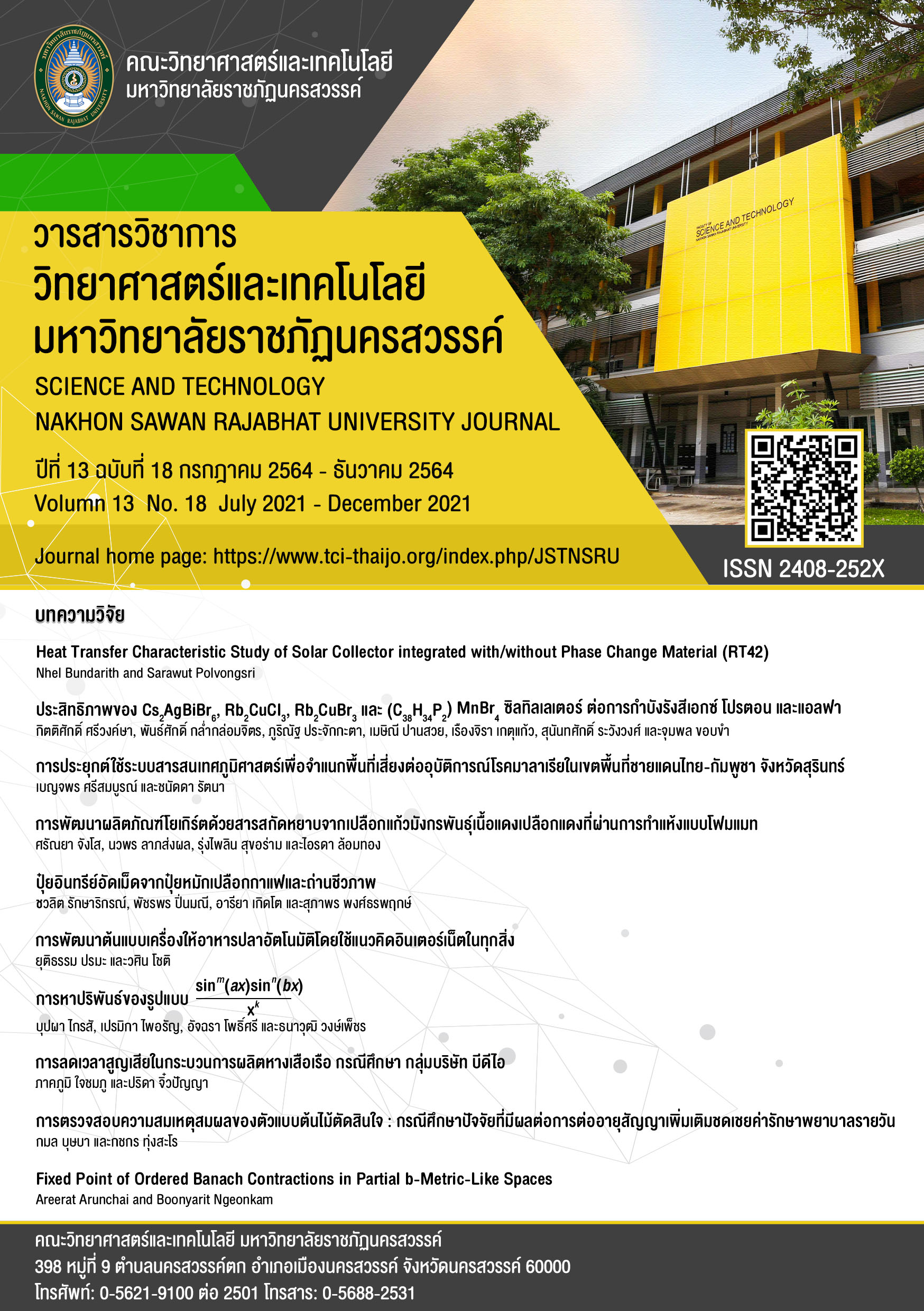การพัฒนาผลิตภัณฑ์โยเกิร์ตด้วยสารสกัดหยาบจากเปลือกแก้วมังกร พันธุ์เนื้อแดงเปลือกแดงที่ผ่านการทำแห้งแบบโฟมแมท
Main Article Content
Abstract
งานวิจัยนี้มีวัตถุประสงค์เพื่อศึกษาผลของการทดแทนเจลาตินด้วยสารสกัดจากเปลือกแก้วมังกรพันธุ์เนื้อแดงเปลือกแดงที่ผ่านการทำแห้งแบบโฟมแมทโดยใช้ไข่ขาว (CE-EW) และโซเดียมเคซีเนต (CE-SC) เป็นสารก่อโฟมต่อคุณสมบัติทางกายภาพ เคมี และประสาทสัมผัสของโยเกิร์ต การทดลองในเบื้องต้นศึกษาคุณสมบัติทางเคมีของ CE-EW และ CE-SC พบว่ามีปริมาณฟีนอลิกทั้งหมด ความสามารถในการต้านอนุมูลอิสระและปริมาณแอนโท
ไซยานินอยู่ในช่วง 2.37-2.95 mg Gallic acid eq./g, 1.11-1.25 mg Trolox eq./g และ 1.49-2.95 mg/L ตามลำดับ ผลการวิเคราะห์คุณสมบัติทางกายภาพและเคมีของโยเกิร์ต 5 สูตร คือ สูตรควบคุม สูตรที่ทดแทน
เจลาตินด้วย CE-EW ร้อยละ 50 และ 100 และสูตรที่ทดแทนเจลาตินด้วย CE-SC ร้อยละ 50 และ 100 พบว่าโยเกิร์ตที่ทดแทนเจลาตินด้วย CE-SC ทั้ง 2 ระดับส่งผลให้ค่าการแยกตัวของน้ำและความหนืดสูงกว่าโยเกิร์ตที่ทดแทนด้วย CE-EW และสูตรควบคุม โยเกิร์ตทุกสูตรมีปริมาณของแข็งที่ละลายทั้งหมดในช่วง 12.33-13.00 องศาบริกซ์ ความเป็นกรด-ด่างอยู่ในช่วง 3.76-3.82 ไขมันอยู่ในช่วงร้อยละ 1.70-1.72 โปรตีนร้อยละ 3.15 และเถ้าร้อยละ 0.14 ซึ่งไม่แตกต่างกันอย่างมีนัยสำคัญทางสถิติ ผลการทดสอบทางประสาทสัมผัสพบว่าการทดแทนเจลาตินด้วย CE-SC ปริมาณร้อยละ 100 ได้คะแนนความชอบด้านลักษณะปรากฏ สี กลิ่น รสชาติ เนื้อสัมผัส และความชอบโดยรวมสูงสุด โดยโยเกิร์ตสูตรดังกล่าวมีค่าความสามารถในการต้านอนุมูลอิสระมากกว่าสูตรควบคุมอย่างมีนัยสำคัญทางสถิติ
Article Details
References
กมลลักษณ์ มาสำโรง และวรพจน์ สุนทรสุข. (2557). ความสามารถในการต้านอนุมูลอิสระและต้านแบคทีเรียของ สารสกัดเปลือกแก้วมังกร. วารสารวิทยาศาสตร์. 45(2), 269-272.
กฤติยา ไชยนอก. (2559, 9 พฤศจิกายน). แก้วมังกร. คณะเภสัชศาสตร์ มหาวิทยาลัยมหิดล. https://pharmacy.mahidol.ac.th/th/service-knowledge-article-info.php?id=366
ประกาศกระทรวงสาธารณสุข. (2556). ราชกิจจานุเบกษา, 130 (ตอนพิเศษ 97 ง), 79-84.
ปิยนุสร์ น้อยด้วง และปัทมา คล้ายจันทร์. (2547). การผลิตโยเกิร์ตกล้วยหอม. วารสารเทคโนโลยีการอาหาร มหาวิทยาลัยสยาม. 1(1), 24-31.
วราภรณ์ ประเสริฐ. (2556). เทคนิคการทำแห้งแบบโฟมแมท. วารสารอาหาร, 43(3), 23-26.
อริสรา โพธิ์สนาม, ชนินทร์ น้อยอามาตย์ และศิริพร แก้วสอาด. (2554). คุณภาพของเม่าผงชงละลายที่ผลิตโดยวิธีการอบแห้งโฟม-แมท. การพัฒนาอนาคตชนบทไทย : ฐานรากที่มั่นคงเพื่อการพัฒนา ประเทศอย่างยั่งยืน. การประชุมวิชาการ มหาวิทยาลัยขอนแก่น ประจำปี พ.ศ.2554 (หน้า 765-769). ขอนแก่น: มหาวิทยาลัยขอนแก่น
อำพรรณ ชัยกุลเสรีวัฒน์, วิญญู ช่วยแก้ว และเนตรนภา สกุลซ้ง. (2557). การผลิตโยเกิร์ตข้าวกล้องพันธุ์ หอมนิล. วารสารวิทยาศาสตร์เกษตร, 45(2) (พิเศษ), 273-276.
Amadou, N. M., Richard, E. A, Jules – Roger, K., Waingeh, N. C., Ateh, K. D., Mbiydzengeh, A. F., Che,
N. S., & Yunenyui, M. P. (2018). Effect of ginger extract on the physicochemical and sensory properties of yoghurt. International Journal of Development Research, 8(5), 20468-20477.
Ambekar, S., Gokhale, S., & Lele, S. (2013). Process optimization for foam mat-tray drying of passiflora edulis flavicarpa pulp and characterization of the dried powder. International Journal of Food Engineering, 9(4), 433-443. https://doi.org/10.1515/ijfe-2012-0185
AOAC. (2000). Offical method of analysis. (17th ed.). Washington. D.C.: The association of office analytical chemists.
Arnao, M. B., Cano, A., & Acosta, M. (2001). The hydrophilic and lipophilic contribution to total antioxidant activity. Food Chemistry, 73(2), 239–244. https://doi.org/10.1016/S0308-8146(00)00324-1
Athar, I. H., Shah, M. A., & Khan, U. N. (2000). Effect of various stabilizers on whey separation (syneresis) and quality of yoghurt. Pakistan Journal of Biological Sciences, 3(8), 1336-1338. https://doi.org/10.3923/pjbs.2000.1336.1338
Chia, S. L., & Chong, G. H. (2015). Effect of drum drying on physico-chemical characteristics of dragon fruit peel (Hylocereus polyrhizus). International Journal of Food Engineering, 11(2), 285-293. https://doi.org/10.1515/ijfe-2014-0198
Damin, M. R., Alcântara, M. R., Nunes, A. P., & Oliveira, M.N. (2009). Effects of milk supplementation with skim milk powder, whey protein concentrate and sodium caseinate on acidification kinetics, rheological properties and structure of nonfat stirred yogurt. Food Science and Technology, 42(10), 1744–1750. https://doi.org/10.1016/ j.lwt.2009.03.019
Esquivel, P, Stintzing, F. C., & Carle, R. (2007). Phenolic compound profiles and their corresponding antioxidant capacity of purple pitaya (Hylocereus Sp.) genotypes. Zeitschrift fur Naturforschung C, 62, 636-644. https://doi.org/10.1515/znc-2007-9-1003
Ferreres, F., Grosso, C., Gil-Izquierdo, A., Valentao, P., Mota, A.T., & Andrade, P.B. (2017). Optimization of the recovery of high-value compounds from pitaya fruit by-products using microwave-assisted extraction. Food Chemistry, 230, 463–474. https://doi.org/10.1016/j.foodchem.2017.03.061
Jamilah, B., Shu, C. E., Kharidah, M., Dzulkifly, M. A. & Noranizan, A. (2011). Physico-chemical characteristics of red pitaya (Hylocereus polyrhizus) peel. International Food Research Journal, 18, 279-286.
Kähkönen, M. P., Hopia, A. I., Vuorela, J., Rauha, J. P., Pihlaja, K., Kujala, T. S., & Heinonen, M. (1999). Antioxidant activity of plant extracts containing phenolic compounds. Journal of Agricultural and Food Chemistry, 47(1), 3954-3962. https://doi.org/10.1021/jf990146l
Karam, M. C., Gaiani, C., Hosri, C., Burgain, J., & Scher, J. (2013). Effect of dairy powders fortification on yogurt textural and sensorial properties: a review. Journal of Dairy Research, 80, 400–409. https://doi.org/10.1017/s0022029913000514
Kumar, P., & Mishra, H. N. (2004). Mango soy fortified set yoghurt: effect of stabilizer addition on physicochemical, sensory and textural properties. Food Chemistry, 87, 501–507. https://doi.org/10.1016/j.foodchem.2003.12.022
Lee, J., Durst, R. W., & Wrolstad, R.E. (2005). Determination of total monomeric anthocyanin pigment content of fruit juices, beverages, natural colorants, and wines by the pH differential method: Collaborative study. Journal of AOAC International, 88(5), 1269-1278. https://doi.org/10.1093/jaoac/88.5.1269
Liu, K. (1997). Soybeans: Chemistry, Technology, and Utilization. New York: Chapman & hall.
Pang, Z., Deeth, H., Sharma, R., & Bansal, N. (2015). Effect of addition of gelatin on the rheological and microstructural properties of acid milk protein gels. Food Hydrocolloids, 43, 340-351. https://doi.org/10.1016/j.foodhyd.2014.06.005
Prabowo, I., Utomo, E. P., Nurfaizy, A., Widodo, A., Widjajanto, E., & Rahadju, P. (2019). Characteristics and antioxidant activities of anthocyanin fraction in red dragon fruit peels (Hylocereus polyrhizus) extract. Drug Invention Today, 12(4), 670-678.
Puvanenthiran, A., Williams, R. P. W., & Augustin, M. A. (2002). Structure and visco-elastic properties of set yoghurt with altered casein to whey protein ratios. International Dairy Journal, 12, 383–391. https://doi.org/10.1016/S0958-6946(02)00033-X
Sengkhamparn, N., Chanshotikul, N., Assawajitpukdee, C., & Khamjae, T. (2013). Effects of blanching and drying on fiber rich powder from pitaya (Hylocereus undatus) peel. International Food Research Journal, 20(4), 1595-1600.
Suh, D. H., Lee, S., Heo, D. Y., Kim, Y. S., Cho, S. K., Lee, S., & Lee, C. H. (2014). Metabolite profiling of red and white pitayas (Hylocereus polyrhizus and Hylocereus undatus) for comparing betalain biosynthesis and antioxidant activity. Journal of Agricultural and Food Chemistry, 62(34), 8764-8771. https://doi.org/10.1021/jf5020704
Tamime, A. Y., & Robinson, R. K.. (1999). Yoghurt Science and Technology. (2nd ed.). Cambridge: Woodhead Publishing Ltd.
Tang, W., Li, W., Yang, Y., Lin, X., Wang, L., Li, C., & Yang, R. (2021). Phenolic Compounds Profile and Antioxidant Capacity of Pitahaya Fruit Peel from Two Red-Skinned Species (Hylocereus polyrhizus and Hylocereus undatus). Foods, 10(6), 1183. https://doi.org/10.3390/foods10061183
Tenore, G. C., Novellino, E., & Basile, A. (2012). Nutraceutical potential and antioxidant benefits of red pitaya (Hylocereus polyrhizus) extracts. Journal of functional foods, 4, 129-136. https://doi.org/10.1016/j.jff.2011.09.003
Wu, L. C., Hsu, H. W., Chen, Y. C., Chiu, C. C., Lin, Y. I., & Annie Ho, J. A. (2006). Antioxidant and antiproliferative activities of red pitaya. Food Chemistry, 95(2), 319–327. https://doi.org/10.1016/j.foodchem.2005.01.002
Wybraniec, S., & Mizrahi, Y. (2002). Fruit flesh betacyanin pigments in Hylocereus cacti. Journal of Agricultural and Food Chemistry, 50, 6086–6089. https://doi.org/10.1021/jf020145k
Wybraniec, S., Platzner, I., Geresh, S., Gottlieb, H. E., Haimberg, M., Mogilnitzki, M., & Mizrahi, Y. (2001). Betacyanins from vine cactus Hylocereus polyhizus. Phytochemistry, 58(8), 1209–1212. https://doi.org/10.1016/s0031-9422(01)00336-3
Yousef, M., Nateghi, L., & Azadi, E. (2013). Effect of different concentration of fruit additives on some physicochemical properties of yoghurt during storage. Annals of Biological Research, 4(4), 244-249.


